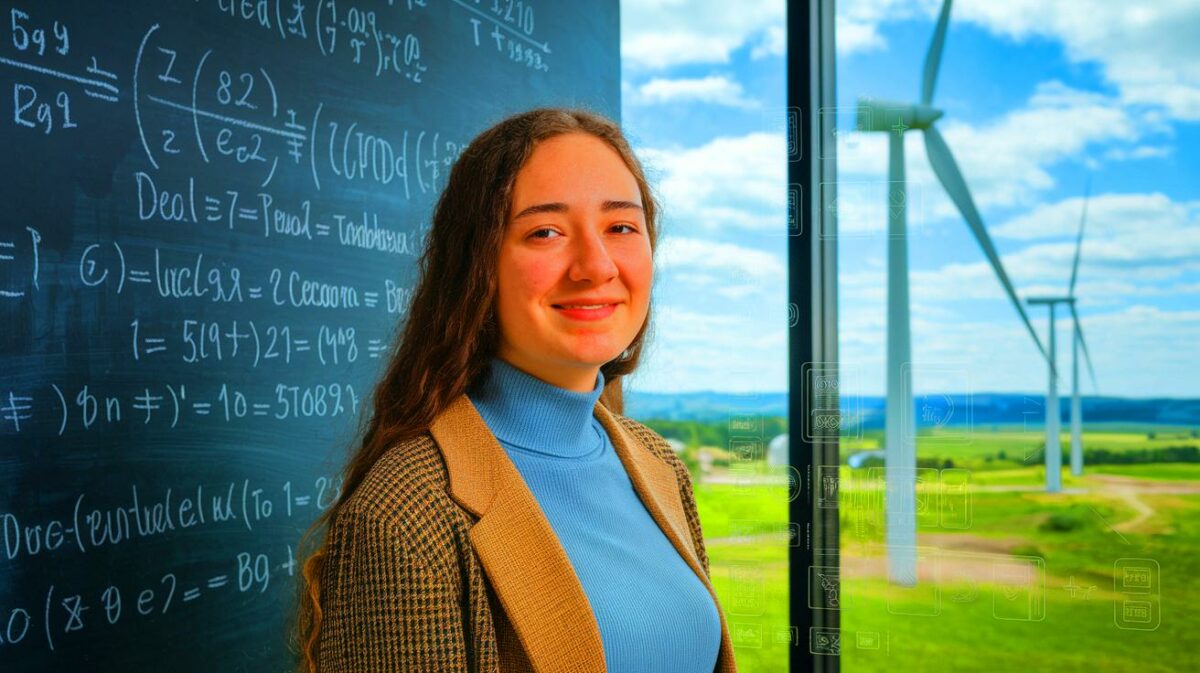| IN A NUTSHELL |
|
In the realm of renewable energy, breakthroughs are rare but transformative. Recently, a groundbreaking discovery by a brilliant Penn State engineering student has sent ripples through the wind energy sector. By revisiting a century-old mathematical problem, this young innovator has unlocked new potential for optimizing wind turbine efficiency. Her work could significantly boost energy production, demonstrating how a fresh perspective can alter the course of technology and sustainability. As the world grapples with increasing energy demands, such advancements are not just welcome—they are essential.
A Revived Mathematical Challenge
Hermann Glauert, a renowned British aerodynamicist, laid the groundwork for optimizing wind turbine performance nearly a century ago. His approach, however, overlooked critical aspects, limiting its effectiveness. Fast forward to today, Divya Tyagi, a graduate student at Penn State, has resurrected Glauert’s challenge. Under the guidance of her professor, Sven Schmitz, she applied advanced techniques such as the calculus of variations to enhance the aerodynamic performance of wind turbines. Her modification identifies optimal flow conditions, maximizing energy output—a feat previously thought unreachable.
Divya’s research was published in the prestigious journal Wind Energy Science. Her innovative approach earned her the esteemed Anthony E. Wolk award for her thesis. In her own words, she has created an addendum to Glauert’s problem, determining the aerodynamic performance of wind turbines by resolving ideal flow conditions. This breakthrough is not only ingenious but could serve as a teaching model worldwide, showcasing the power of rethinking traditional problems.
Overcoming Challenges Through Persistence
Divya Tyagi’s journey was not without its hurdles. The mathematical rigor required to tackle this century-old problem demanded her unwavering dedication for 10 to 15 hours each week. Despite the challenges, Divya remained resolute, driven by the desire to contribute meaningfully to renewable energy advancements. Reflecting on her journey, she expressed immense pride in her accomplishments, acknowledging the intense effort it took to reach this point.
Her mentor, Sven Schmitz, recognized the gaps in Glauert’s original solution and posed the challenge to his students. Among them, Divya stood out, rising to the occasion with a solution that not only addressed the problem but also offered an elegant resolution. Her success is a testament to her perseverance and the potential for academic challenges to inspire real-world innovations.
Toward a New Generation of Wind Turbines
The implications of Divya’s research are profound. Even a 1% improvement in the coefficient of power could significantly boost wind energy production—enough to power an entire neighborhood. Her work paves the way for more efficient wind turbines by addressing factors previously neglected, such as total force and moment coefficients on the rotor and blade flexing under wind pressure.
This newfound knowledge has the potential to transform the energy sector, leading to the development of next-generation turbines that are not only more efficient but also more environmentally friendly. As the demand for clean energy grows, such innovations are critical for meeting global energy needs while minimizing environmental impact.
The Legacy of Hermann Glauert
Hermann Glauert, born in Sheffield in 1892, was a pioneering figure in aeronautics until his untimely death in 1934. A Trinity College graduate from Cambridge, Glauert received numerous accolades, including the Tyson Medal for Astronomy and the Rayleigh Prize for Mathematics. His work, particularly the Prandtl-Glauert method, remains influential in aeronautical engineering.
Divya Tyagi’s advancements build upon Glauert’s foundational theories, highlighting the evolution of engineering and the impact of new perspectives on solving longstanding problems. As we look to the future, it is crucial to explore how these insights can be applied to meet growing energy demands while safeguarding our fragile environment.
With these innovative developments in wind energy, the question remains: how will the industry adapt and implement these advancements to achieve a sustainable future? As we continue to innovate, the potential for change is vast, but the path forward must be carefully navigated to balance technological progress with environmental stewardship.
Did you like it? 4.4/5 (29)









Wow, incredible work by Divya! 🌟 How long did it take her to crack this problem?
Thank you Divyal! Sorry you had to “clean up” after another male! Woman do this all the time. I hope you younger women will take over leadership soon…nice to have another female show the world who is actually in charge and is the the more intelligent homosapien sapien!
my oh my..here’s another engineering problem that may e Divya or another woman could solve…how to remove Terri’s chip from her shoulder as efficiently and painlessly as possible.
‘Tyagi’ means person who sacrificed personal life interests for the sake of the public. ‘Divya’ means Divine.
This is amazing. Imagine the possibilities if more students tackled age-old problems! 😃
Did she work alone or was this a team effort with her professor?
I’m curious, how much actual energy can a 1% increase provide? Enough for a small town?
This is a testament to the power of perseverance. Well done, Divya! 👏
Can someone explain what “calculus of variations” is in layman’s terms?
I hope this encourages more women to enter STEM fields. Go Divya!
What an achievement! Does she plan to continue in academia or enter industry?
Is it possible to apply her solution to existing turbines, or only new ones?
Maybe we should rethink the curriculum to include solving old problems. Thoughts?
The impact of this is huge. Can’t wait to see how the industry reacts! 😮
I’m curious to read her paper. Is it accessible to the public?
Does this mean wind energy will become cheaper in the future?
Absolutely incredible! Who knew a dorm room could be a hub of innovation? 🏆
How does this affect the lifespan of wind turbines?
I’m amazed by her dedication. How did she balance this with her studies? 🤔
Hope this inspires more students to tackle big problems. Congrats, Divya!
Can this be applied to other renewable energy sources like solar?
What are the next steps for implementing this solution in the real world?
Wait, so Glauert’s work was incomplete all this time? Interesting!
Her dedication is inspiring. 10-15 hours a week? That’s commitment! 🙌
Such a great read. I wonder if she’ll inspire a new generation of engineers.
Isn’t it ironic that a problem from the past is paving the way for the future? 🤯
Does her research suggest any improvements for turbine design?
How was Hermann Glauert’s original work received back in his day?
Great job, Divya! How were her findings received by the wider scientific community?
It’s refreshing to see academia contributing to real-world solutions. Well done! 👍
She must be really proud of her achievements. What a role model!
Imagine what other breakthroughs are waiting to be discovered in old research! 🧠
I’m so impressed. Is there any way to support her future research efforts?
What other applications might this new mathematical insight have beyond wind turbines?
I’m skeptical. How can a century-old problem be solved so easily in a dorm room?
Anyone know how this impacts the cost of wind energy production?
Thank you Divyal! Sorry you had to “clean up” after another male! Woman do this all the time. I hope you younger women will take over leadership soon…nice to have another female show the world who is actually in charge and is the the more intelligent homosapien sapien!
Big kudos to her mentor too! Sven Schmitz deserves some credit! 🎓
Why haven’t more of these old problems been revisited? Seems like a goldmine for innovation.
Google the following, “Glauert’s optimum rotor disk revisited–a calculus of variations solution and exact integrals for thrust and bending moment coefficients” and a link to the paper comes up. The abstract,
“Abstract. The present work is an amendment to Glauert’s optimum rotor disk solution for the maximum power coefficient, CPmax , as a function of tip speed ratio, . First, an alternate mathematical approach is pursued towards the optimization problem by meansofcalculus of variations. Secondly, analytical solutions for thrust and bending moment coefficients, CT and CBe, are derived, where an interesting characteristic is revealed pertaining to their asymptotic behavior for . In addition, the limit case of the non-rotating actuator disk for 0 is shown for all three performance coefficients by repeated use of L’Hôpital’s theorem, and its validity is discussed in the context of other works since Glauert.”
If the image is representative, it may be required to mention that the image is representative since that person in the image is not divya tyagi
Here’s a detail I think is missing from this article. Current average wind turbine efficiency? Possible increased average efficiency using Divya’s calculations? Thank you.
This is agreat,achievement,only possibleif onehas passed through the Ancient University,where everything originated. Well done Engineer Divya Tyagi. GOD Blessed you .
Why is a random girls image used instead of Divya’s?
Lazy journalism.. (Clearly the person in the photo isn’t of Indian origin?)
That lead image is a bunch of AI generated junk. It’s not an image of Divya and the symbols on the board are surprisingly less mathematical than a recent formula for calculating tariff rates.
my oh my..here’s another engineering problem that may e Divya or another woman could solve…how to remove Terri’s chip from her shoulder as efficiently and painlessly as possible.
Academics, scientists, engineers, biologists, chemists, those in the medical professions…your dedication and perseverance is changing our planet and it’s inhabitants in the most amazing ways…I hope you Divya, and all those colleagues in other fields can own how amazing you all are.
Join the thousands who trust us for their auto loans. With fast approvals and low monthly payments, hitting the road is easier than ever. Apply Now and Start Your Journey! [email protected]
Great way to write a story and tell your audience a single thing